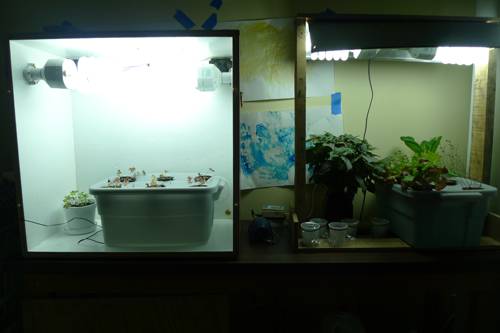
FAQ About Indoor Hydroponic Plant Systems

What is an indoor hydroponic plant system?
An indoor hydroponic plant system is a method of growing plants without soil by using mineral nutrient solutions in a water solvent. These systems provide an efficient way to cultivate plants by directly delivering nutrients to the plant roots, typically used indoors where conditions such as light, temperature, and humidity can be controlled.

What are the benefits of using indoor hydroponic systems?
Indoor hydroponic systems offer several advantages, such as faster plant growth, reduced water usage, and year-round cultivation. These systems allow for precise nutrient control and can be situated in areas with limited space. Additionally, they minimize soil-borne diseases and pests, offering a cleaner growing environment.

How does hydroponics differ from traditional soil gardening?
Hydroponics differs from traditional soil gardening by eliminating the use of soil. In hydroponics, plants are grown in nutrient-rich water solutions that supply all necessary minerals, leading to more efficient nutrient uptake and faster growth rates. This method also allows for greater control over the growing environment and resource utilization.

What types of plants can be grown in hydroponic systems?
Many types of plants can be grown in hydroponic systems, including leafy greens like lettuce and spinach, herbs such as basil and mint, and some fruiting plants like tomatoes and strawberries. Root vegetables and very large plants may be less suitable due to space and support limitations.

How do I start setting up an indoor hydroponic system?
Setting up an indoor hydroponic system involves selecting a system type (such as NFT, DWC, or Ebb and Flow), acquiring the necessary equipment like grow lights, nutrient solutions, and grow trays, and setting up a controlled environment that suits the plants you wish to grow. It's helpful to start with a simple system if you're new to hydroponics.

What equipment is needed for an indoor hydroponic system?
The essential equipment for an indoor hydroponic system includes grow lights, a growing tray or reservoir, water pumps, air pumps, growing mediums like rockwool or clay pellets, and nutrient solutions. Some setups may require more specialized equipment depending on the complexity of the system.

Are there different types of hydroponic systems?
Yes, there are several types of hydroponic systems, including Nutrient Film Technique (NFT), Deep Water Culture (DWC), Ebb and Flow, Aeroponic, and Wick systems. Each system has unique characteristics and benefits, making them suitable for different types of plants and growing conditions.

What is the Nutrient Film Technique (NFT) in hydroponics?
The Nutrient Film Technique (NFT) is a hydroponic method where a thin film of nutrient-rich water continuously flows over the roots of the plants. This allows plants to absorb nutrients effectively while maintaining sufficient oxygen levels. NFT systems are best suited for fast-growing, shallow-rooted plants.

How do I maintain a hydroponic system?
Maintaining a hydroponic system involves monitoring and adjusting nutrient levels and pH, ensuring consistent lighting, keeping the system clean, and routinely checking equipment such as pumps and reservoirs. It's also crucial to watch for and promptly address any signs of plant stress or disease.

What are some common problems in hydroponic systems and how can they be resolved?
Common issues in hydroponic systems include nutrient imbalances, pH fluctuations, and water contamination. These can often be resolved by regularly monitoring nutrient and pH levels, maintaining clean water sources, and ensuring proper filtration. Adequate ventilation can also prevent fungal infections and plant diseases.

What is pH, and why is it important in hydroponics?
pH levels indicate the acidity or alkalinity of the hydroponic solution, and they significantly affect nutrient availability to plants. In hydroponics, maintaining a pH range of 5.5 to 6.5 is typically ideal, as it ensures optimal nutrient uptake. Regular pH testing and adjustments are necessary to maintain this balance.

Can hydroponic systems be automated?
Yes, hydroponic systems can be automated using timers, sensors, and controllers to manage tasks such as lighting, nutrient dosing, and climate control. Automation makes maintenance easier and more consistent, particularly for larger or more complex setups.

How much does it cost to set up an indoor hydroponic system?
The cost of setting up an indoor hydroponic system can vary widely based on size, complexity, and the type of plants being grown. A small, basic setup may cost a few hundred dollars, while larger, more advanced systems with automation could run into the thousands. Researching and planning based on your specific needs can help manage costs.

What are growing mediums in hydroponics, and why are they used?
Growing mediums in hydroponics act as a support structure for plant roots instead of soil. Common mediums include rockwool, perlite, vermiculite, and clay pellets, each providing unique properties that aid in water retention, nutrient distribution, and root support. Choosing the right medium can influence plant health and growth.

Do hydroponic plants grow faster than soil-grown plants?
Yes, plants grown hydroponically often grow faster than those in soil due to more efficient nutrient uptake and optimized growing conditions. This accelerated growth is a result of controlled nutrient delivery and environmental factors, which can lead to higher yields within a shorter time frame.

Is it possible to grow fruiting plants indoors using hydroponics?
Yes, many fruiting plants can be grown indoors using hydroponics, such as tomatoes, strawberries, and peppers. These setups typically require more attention to light and nutrient needs to support fruit production. Selecting dwarf or bush varieties can also be beneficial for indoor spaces with limited height.

How does one control pests in an indoor hydroponic system?
Pest control in indoor hydroponic systems is typically managed through preventative measures such as maintaining clean equipment and growing environments, using pest-resistant plant varieties, and introducing beneficial insects when necessary. Physical barriers and organic pesticides can also be employed if pests appear.

What role do grow lights play in an indoor hydroponic system?
Grow lights are crucial in indoor hydroponic systems as they provide the necessary spectrum of light for photosynthesis, which is essential for plant growth. LED and fluorescent lights are commonly used due to their efficiency and lower heat output, allowing for flexible positioning and intensity control.

Can herbs be grown in indoor hydroponic systems?
Yes, herbs such as basil, mint, cilantro, and parsley thrive in indoor hydroponic systems. These setups allow for easy control over growth conditions and can yield fresh herbs throughout the year. Hydroponic systems are particularly advantageous for growing herbs at home due to space efficiency and ease of maintenance.

What is deep water culture (DWC) in hydroponics?
Deep Water Culture (DWC) is a hydroponic method where plant roots are suspended in a nutrient-rich water solution. An air pump provides oxygen to the roots, allowing them to access nutrients and oxygen simultaneously. DWC systems are known for their simplicity and effectiveness, especially in growing leafy greens and herbs.
